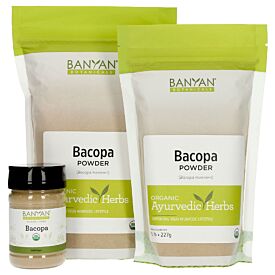11 Ayurvedic Tips to Improve Focus
One of the main goals of Ayurveda is to bring balance to the mind and body so that we may live to our highest potential. When mental clarity and focus are a challenge, it is difficult to live to our fullest. Increased vata is often associated with inhibited concentration, however sugar imbalances (more often associated with increased pitta or kapha) can also play a role. Sometimes improving focus and increasing concentration is as simple as following some of Ayurveda’s basic guidelines for living in harmony with the cycles of the earth. Below are eleven ways you can improve mental clarity naturally with Ayurveda.
Commit to a Daily Routine
Following a regular routine can help you improve focus by balancing vata dosha and creating a sense of stability and predictability to the day. This consistency allows you to concentrate more easily because you’re not focused on planning your day or making decisions on the fly. Rise at around the same time each morning, ideally around 6 a.m. and go to bed at or before 10 p.m. In addition, eat meals at around the same time each day, and don’t skip lunch! The body requires regular refueling to stay focused. However, avoid snacking or grazing throughout the day, as the body is not able to efficiently break down and assimilate nutrients unless meals are spaced at least three hours apart.
Do the Right Work at the Right Time
The wisdom of Ayurveda teaches that each time of day has a corresponding dosha.
The morning hours from 6 a.m. until 10 a.m. are kapha time. We tend to be calmer and naturally a little more focused at this time. This is a good time to check items off the “to-do” list, get paperwork done, and connect with people. Kapha’s nurturing energy can support successful communication.
From 10 a.m. until 2 p.m., pitta dominates. Pitta brings an energy of motivation and drive. The mind is likely to be most decisive, analytical, and logical at this time, so approach projects that require these skills during the middle part of the workday.
The afternoon hours from 2 p.m. until 6 p.m. are considered vata time. The mind is often less focused and may be somewhat fatigued. Instead of clear and decisive, the mind is more creative, intuitive, and mobile during this time. Trying to work on projects that require focus between 2 and 6 p.m. may be counterproductive. Instead, harness the vata energy of this time to brainstorm and dream up new ideas. This may also be a good time to put together a creative plan for the following day, as random thoughts of what you would like to get done may surface at this time.

Cleanse to Clarity
The fastest and most complete way I know of to get mental functioning back on track is with a two-week cleanse. Ayurveda utilizes a special cleansing method called oleation, which is kind of like oil pulling for the whole body. By ingesting increasing amounts of ghee or oil first thing in the morning for seven days (and only under the guidance of a practitioner), the body is able to pull fat-soluble natural toxins out of the system and move them to the GI tract for elimination. This removal of natural toxins supports our ability to think well and boosts focus. Once the cleanse is complete and the mind and body find their natural return to balance, we are able to experience strong, stable energy, and mental clarity throughout the entire day.
This has been a very powerful experience for many people who have cleansed with me—and it was for me when I first cleansed the Ayurvedic way. Usually around day 5 or 6 of ghee ingestion, people start to notice that they feel hungry without feeling as if they’re going to crash or that their brain has stopped working. The mind becomes clearer and a lightness sets in where there was previously fog. The ghee in combination with herbs that support normal blood sugar levels is especially helpful.
Move Your Body
Starting the day with some physical activity can offer a major boost to focus and concentration. As noted above, from 6 a.m. until 10 a.m. kapha dominates; muscles are strongest and our stamina is at its peak. This is a good time to go for a hike or run, or exercise in the gym before starting the workday. Studies have shown that physical activity can increase the size of the hippocampus, the part of the brain connected to verbal memory and learning.1 Exercise also triggers the release of endorphins that support focus and our ability to prioritize.2
Sometimes focus begins to wane after several hours sitting at a computer or in a series of meetings. Get up and get a little physical activity often throughout the workday. Taking a walk around the block in the fresh air is ideal, but if that isn’t possible, get a drink of water, do a few Sun Salutations, or do a series of lunges across the room. If you work in a large office with other people around (who might think your Sun Salutations in the middle of the office are a bit…odd), then take a bathroom break and do a few Standing Forward Folds or a Side Angle sequence that requires little space.
Do a Daily Oil Massage
When lack of focus is related to excess vata, a daily self-massage using oil (called abhyanga) can help enormously. This is best practiced just before a bath or shower, but do it any time that works for your schedule. Choose organic, unrefined sesame oil or another massage oil for your constitution type, and start the application at the top of the head. If you are unsure of your constitution type, take the Ayurvedic Profile™ quiz. You’ll also get specific, personalized oil recommendations when you take the quiz.
How to Do a Self-Massage
First, warm the oil and massage a little oil along the part of the hair, then move down to the forehead, and make sure to massage the ears and behind the ears. Continue working down along the body, using circular motions on joints and over the stomach (following the direction of digestion—down the left and up the right side of the abdomen), and long strokes along the long bones of the body. Always move in the direction of blood flow; massage from the shoulder to the elbow, make circles around the elbow joint, and then massage in long strokes from the elbow to the wrist.
After covering the body, wait ten minutes (try putting on a bathrobe and doing one or two short tasks around the house—note that the bathrobe will absorb some of the oil, so don’t use your favorite one), and then take a warm bath or shower. There is no need to wash the oil off with soap, allow it to soak in and nourish the skin. If you have a tendency toward very dry skin, you can reapply after getting out of the bath and drying off. It’s a good idea to have a special towel reserved for drying off as it will absorb the oil and eventually get ruined. Abhyanga calms the central nervous system, thus contributing to better focus. In addition, the application of oil touches various marma points on the body that bring balance and clarity of mind.

Practice Meditation Daily
The Vedas (ancient texts) identify a time in the early morning, generally between 5 and 6 a.m., called brahmamahurta. This is a time of peace and quiet and is considered the best time to meditate because the mind is clear. By starting the day with a meditation practice, we are able to carry these calm and clear qualities into the rest of our day. Those with a vata imbalance may benefit from sleeping a little later, although a meditation practice is still recommended. Although this early morning time is considered ideal, meditating at whatever time works best for your schedule is most important.
Consider Taking Bacopa
Bacopa (Bacopa monnieri) is lovingly referred to by many as the herb of universal consciousness. It is an herb that is known to sharpen the intellect, improve focus and memory, and promote awareness.
As a graduate school student, Banyan’s tablet formula called Mental Clarity, which features bacopa as a key ingredient, has been a total life-saver (or grade-saver) for me. In addition to improving memory and focus, bacopa helps support a calm mind and speeds up communication between neurons in the brain.3 Bacopa is an adaptogen, which means it changes the way the body responds to stress. Therefore, the effect of the herb is not only active while taking it—its stress-relieving benefits continue even after discontinuing use.
Support Balanced Blood Sugar with Shardunika
If you notice focus is especially difficult just before meal times, when a feeling of “crashing” may occur, adding the herb Shardunika (Gymnema sylvestre) might be helpful. Shardunika is known as the “sugar destroyer” and can promote steady energy throughout the day by supporting balanced blood sugar levels. Like bacopa, this herb has been a game changer for me. I first tried it when I was undergoing my second Ayurvedic cleanse. At that time, I was having a lot of problems with sugar crashes throughout the day (although I didn’t really know that was what was happening at the time). I couldn’t think clearly, I was irritable when hungry, and would go into a full-stop mode until I could refuel. Once I started taking Banyan’s Sweet Ease formula, I was able to step out of the fog. Now I take shardunika daily to support blood sugar balance.

Choose Grounding Foods
Root vegetables, such as carrots, beets, potatoes, yams, sweet potatoes, fennel bulb, and parsnips, contain the grounding quality of the earth element that balances the air and space elements of vata. Protein, such as nuts, seeds, eggs, fish, and poultry, are also balancing to vata while supporting blood sugar balance by releasing stored glucagon from the liver. Eat these foods warm with plenty of spices to improve mental clarity and focus. Of course, how you eat is just as important; be sure to eat these foods in a grounded manner by sitting in a comfortable, quiet place away from distractions. Eating while driving or checking email can increase vata and negate the benefits of these grounding foods.
Try Nadi Shodhana (Alternate Nostril Breathing)
Nadi shodhana, which translates as “alternate nostril breathing,” is a simple breathing technique that balances all doshas and encourages a calm, steady mind. This can be done anywhere—at home, at work, in a parking lot before going into the grocery store (although not while driving!)— and only takes a few minutes to complete several rounds.
To practice, start by sitting in a comfortable seated position. If possible, close your eyes. Using the right hand, align the thumb gently alongside the right nostril and align the ring finger gently alongside the left nostril. Close off the left nostril and breathe in through the right nostril. Close off the right nostril, hold the breath in for one or two seconds, then release the left nostril and allow the breath to flow out of the left nostril. Pause for a moment at the end of the exhale, then reverse this: inhale through the left nostril, close it off, hold the breath for one or two seconds, then release the right nostril and let the breath flow out of the right nostril. This is one round. Repeating this ten times is a nice way to reset focus and mental clarity at any time of day.
Strike a Yoga Pose
If you don’t already have a daily yoga practice, and you are struggling with focus, now is a good time to implement one. If you already have a regular practice, take a moment to assess how it is serving you. A fast-moving, flowing yoga practice is good for getting the blood moving and triggering the endorphins we talked about in “move your body,” but too much movement can aggravate vata and actually sabotage your focus efforts.
Integrate periods of static yoga into your practice; choose a few poses that can be held for several breaths. Some good examples are standing poses like Warrior I (Virabhadrasana I), Warrior II (Virabhadrasana II), Humble Warrior (Baddha Virabhadrasana), and Extended Triangle (Utthita Trikonasana). Try moving into one of these poses, then stay for ten breaths. Remain present during each breath. If the pose becomes intense, notice how you respond to the intensity and continue to breathe. (Intensity is okay, but you should not be in pain.)
Seated and prone (lying) yoga poses can also help with focus and mental clarity because they have a grounding quality that balances vata. Try practicing some of these grounding poses just before Savasana. Examples are Childs Pose (Balasana) Pigeon Pose (Kapotasana), Double Fire Log (Agnistambhasana), and Alternating Knees to Chest (Apanasana).
A Final Word
Not sure where to start to get focus back? Choose one or two items from this list that are easy to implement and start them today. In a week, try adding another. It is not necessary to implement all items on this list, just find a few that work for you. Identifying whether your focus challenges are due to increased vata, blood sugar imbalances, or another cause is key to getting the brain back on track, so seeing an Ayurvedic practitioner may help.












